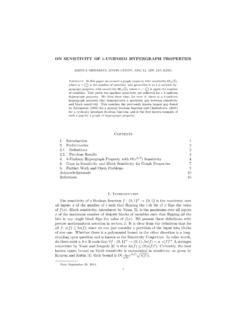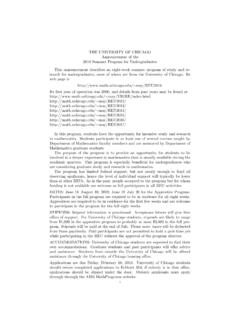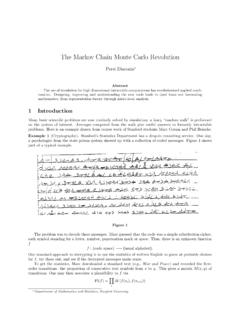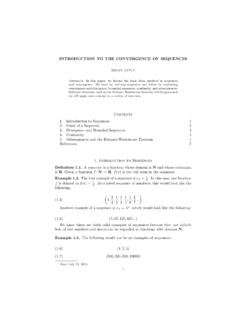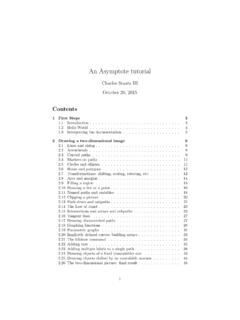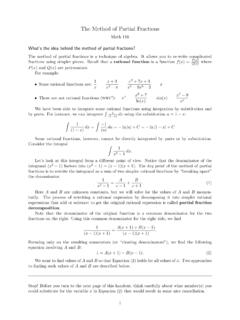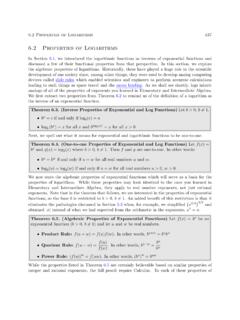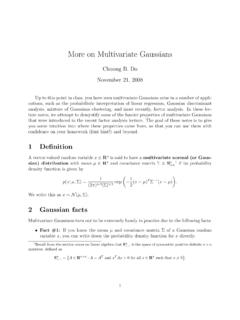Transcription of The Pigeonhole Principle Solutions - University of Chicago
1 The Pigeonhole PrincipleSolutions If you shove 8 pigeons into 7 holes, then there is a hole with at least 2 pigeons. people are swimming in the lake. Prove that at least two of them wereborn on the same day of the people are the pigeons and the days of the week are the pigeonholes. There are only7 days in a week and 10 people, therefore at least two of them were born on the same dayof the children are in an elevator. Prove that at least three of them wereborn on the same day of the no more than two children were born on each day of the week, then there could be atmost 14 children. Since there are 17 children, there must be a day of the week on whichat least 3 of them were the cat likes to wear socks on all four of its feet. Briar s sock draweris filled with yellow, cyan, and pink socks. Every morning Briar pulls socksout of the drawer one at a time until four matching socks are found. What isthe largest number of socks Briar may pull from the drawer before finding acomplete set?
2 Think about the worst Briar could do: if the cat pulls 3 socks of each color (for a totalof 9 socks) then it still does not have enough to make a matching set, but if a 10th sockis chosen then it must complete one set of matching socks. Therefore 9 socks is the mostBriar can pull without getting a writes down random positive integers when she gets bored. Prove thatif Sarah writes 1001 numbers, then there must be at least 2 with the samelast three there are 10 digits, there are only 103= 1000 possibilities for the last three digits ofa positive integer. If Sarah writes down 1001 numbers, then by the Pigeonhole principleshe must have at least 2 numbers with the same last three is coloring in the squares on a (really really big) sheet of graph paperwith red and green pencils. Her goal is to color all the squares on the pageso that there is no rectangle all of whose corners are the same color (Simonecalls such rectanglesunichromeand she hates them.)
3 For example, the picturebelow shows a successful start on the left and a failure on the right. This is afailure since the 4 boxes in the corner of this rectangle are all red.(a)Prove that it is impossible for Simone to successfully color the entire sheetof graph paper without any unichrome a 3 9 portion of the grid. Each column has 3 boxes and thus one of thecolors must appear twice by the pigeon hole Principle . There are only 23= 8 waysto color 3 boxes either red or green. Since there are 9 columns in this grid, one ofthe colorings must appear twice. Whichever color repeats in this column gives us aunichrome rectangle. See the picture below.(b)What is the largest3 nbox Simone can color without making a unichromerectangle?Notice that in the picture above there is only one column that repeats, but there areactually several unichrome rectangles. The problem comes from the columns thatare all one color (unichrome columns.) Suppose we use all the other column coloringsexactly we try to add one more column, then either it will repeat one already colored orit will be a unichrome column.
4 Repeating a column gives a unichrome rectangle anda unichrome column (say its red) will make a unichrome rectangle with any columnthat repeats red. What is the biggest 3 nbox we can color without a unichromerectangle if we include a unichrome column?(c)Prove that using 3 colors instead of 2 will not help Simone avoid thedreaded unichrome the same idea as before, consider a 4 82 portion of the grid (remember, herpaper is really really big.) Then by the Pigeonhole Principle each column must havea repeated color and there are only 34= 81 different column colorings. Hence somecolumn coloring will be repeated and thus we will have inevitably have a you generalize this argument to show that no matter how many colors Simoneuses, she will never be able to realize her unichrome-free dreams? picks 7 numbers from{1,2,3,..,10,11}. Prove he has a pair that addup to the following partition of Devon s available numbers:{1,11},{2,10},{3,9},{4,8},{5,7}, {6}.
5 Since there are only 6 parts to this partition, Devon s 7 numbers must have at least 2numbers living in the same part (hence that part is not{6}which only has one numberin it.) But all the parts with two numbers add up to 12! notices that whenever she selects 7 whole numbers, there is always atriplea,b,cof numbers in her collection that all differ from each other by amultiple of 3. Tammy conjectures this will always be the case. Prove Tammy are only 3 possible remainders when dividing a whole number by 3, namely 0, 1,or 2. No matter which 7 numbers Tammy chooses, they each have one of these 3 remain-ders, hence by the Pigeonhole Principle there must be at least 3 numbers with the sameremainder. If two numbers have the same remainder when divided by 3, their differenceis divisible by Queen has a garden in the shape of an equilateral triangle with each sidemeasuring 2 kilometers. The 5 royal children like hide in the garden as faraway from each other as possible.
6 Prove that no matter how hard they tryto get away from each other, there are still always two royal siblings within 1kilometer of each Queen s garden can be split into 4 smaller equilateral triangles each with side length1 kilometer. Each of the 5 children must be in one of these smaller triangles, hence bythe Pigeonhole Principle there must be a small triangle with 2 royal children. But anytwo children in the same small triangle are within 1 kilometer of each any two people, they have either high fived each other at least once intheir lives or they have not. Prove that if there are 6 people in a library, thenthere are 3 of them who have either all high fived one another or who havenever high fived one Esteban is one of the library patrons. He labels each of the other 5 people withan H if they have high fived and with an N if they have never high fived. By the pigeon-hole Principle , there are at least 3 people with one of the 2 labels.
7 Suppose without lossof generality that they are labeled H. If any of those 3 people have high fived one another,then together with Estaban they form a group of 3 mutual high fivers. If not, then the 3of them form a group who have never high fived one another. Either way we get a groupof 3 as we capon a sphere is a hemisphere including the circle on its that for any 5 points on a sphere, there is some closed cap containingat least 4 of plane passing through the center of a sphere intersects the sphere in a circle dividingthe sphere into two equal pieces. These are calledgreat circles. Given any two pointson a sphere, there is a great circle passing through both of them (since there is a planepassing through these two points and the center of the sphere.)If we have 5 points on a sphere, pick 2 of them and consider a great circle passing throughthem. This circle divides the sphere into two halves. Of the remaining 3 points, theremust be one half of the sphere containing 2 of them (or they could be on the great cir-cle.)
8 Either way, that half of the sphere together with the great circle forms a closed capcontaining 4 of the that 101 positive integers are arranged in a circle. The sum of all thenumbers is 300. Prove that you can always choose a consecutive sequence ofnumbers which sum to one of the numbers on the circle and call ita1. Label the numbers clockwise asa1,a2,..,a101. Now consider the sumssk=a1+a2+..+ak,for 1 k 101. Thenskis an increasing sequence of 101 different integers (why are theyall different?) between 1 and 300. Since there are only 100 possibilities for the last twodigits of these numbers, there must be somesiandsi+jwith the same last two +j siis positive, divisible by 100, and strictly less than 300. This only leavestwo possibilities:si+j si= 100 or 200. On the other hand, note that this difference isa sum of consecutive numbers on the circle,si+j si=ai+1+ai+2+..+ai+ the difference is 200 then we are done.
9 If the difference is 100, then the sum of theremaining numbers on the circle must be 200 (since in total they all sum to 300.) is a real number andn 1is a whole number, show there is a rationalnumberp/qso that pq < will need the notion of thefractional partof a real number. The fractional part ofa number is the part to the right of the decimal point. Given any real number , let{ }be the fractional part of . For example, = its fractional part is{ }=. The two important properties of the fractional part of a number are (1)that 0 { }<1 for any real number , and (2) that { }is always a whole then+ 1 real numbers 0 ={0 },{ },{2 },{3 },..,{n }. These numbersall live in the interval [0,1). Suppose we break this interval up intonpieces [0,1/n),[1/n,2/n), .. , [(n 1)/n,1). Then each of then+ 1 numbers must belong to one ofthese pieces, hence by the Pigeonhole Principle there must be an interval with at leasttwo different numbers in it.]]]]
10 That is, for somem 0 andq >1 we have both{m }and{(m+q) }in the same interval of length 1/n. But then their difference (m+q) m =q has fractional part in [0,1/n). Letpbe the integerp=q {q }. Then rearranging wehave|q p|=|{q }|< both sides of this inequality by the positive integerqgives us pq <1nq.]

